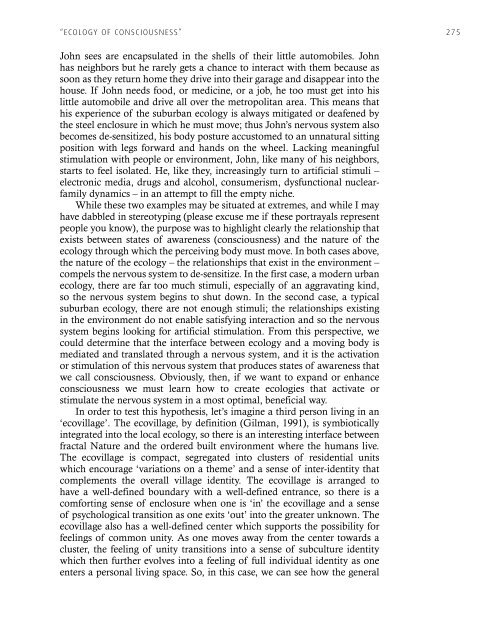Designing Ecological Habitats - Gaia Education
Designing Ecological Habitats - Gaia Education
Designing Ecological Habitats - Gaia Education
You also want an ePaper? Increase the reach of your titles
YUMPU automatically turns print PDFs into web optimized ePapers that Google loves.
“ecology of consciousness” 275<br />
John sees are encapsulated in the shells of their little automobiles. John<br />
has neighbors but he rarely gets a chance to interact with them because as<br />
soon as they return home they drive into their garage and disappear into the<br />
house. If John needs food, or medicine, or a job, he too must get into his<br />
little automobile and drive all over the metropolitan area. This means that<br />
his experience of the suburban ecology is always mitigated or deafened by<br />
the steel enclosure in which he must move; thus John’s nervous system also<br />
becomes de-sensitized, his body posture accustomed to an unnatural sitting<br />
position with legs forward and hands on the wheel. Lacking meaningful<br />
stimulation with people or environment, John, like many of his neighbors,<br />
starts to feel isolated. He, like they, increasingly turn to artificial stimuli –<br />
electronic media, drugs and alcohol, consumerism, dysfunctional nuclearfamily<br />
dynamics – in an attempt to fill the empty niche.<br />
While these two examples may be situated at extremes, and while I may<br />
have dabbled in stereotyping (please excuse me if these portrayals represent<br />
people you know), the purpose was to highlight clearly the relationship that<br />
exists between states of awareness (consciousness) and the nature of the<br />
ecology through which the perceiving body must move. In both cases above,<br />
the nature of the ecology – the relationships that exist in the environment –<br />
compels the nervous system to de-sensitize. In the first case, a modern urban<br />
ecology, there are far too much stimuli, especially of an aggravating kind,<br />
so the nervous system begins to shut down. In the second case, a typical<br />
suburban ecology, there are not enough stimuli; the relationships existing<br />
in the environment do not enable satisfying interaction and so the nervous<br />
system begins looking for artificial stimulation. From this perspective, we<br />
could determine that the interface between ecology and a moving body is<br />
mediated and translated through a nervous system, and it is the activation<br />
or stimulation of this nervous system that produces states of awareness that<br />
we call consciousness. Obviously, then, if we want to expand or enhance<br />
consciousness we must learn how to create ecologies that activate or<br />
stimulate the nervous system in a most optimal, beneficial way.<br />
In order to test this hypothesis, let’s imagine a third person living in an<br />
‘ecovillage’. The ecovillage, by definition (Gilman, 1991), is symbiotically<br />
integrated into the local ecology, so there is an interesting interface between<br />
fractal Nature and the ordered built environment where the humans live.<br />
The ecovillage is compact, segregated into clusters of residential units<br />
which encourage ‘variations on a theme’ and a sense of inter-identity that<br />
complements the overall village identity. The ecovillage is arranged to<br />
have a well-defined boundary with a well-defined entrance, so there is a<br />
comforting sense of enclosure when one is ‘in’ the ecovillage and a sense<br />
of psychological transition as one exits ‘out’ into the greater unknown. The<br />
ecovillage also has a well-defined center which supports the possibility for<br />
feelings of common unity. As one moves away from the center towards a<br />
cluster, the feeling of unity transitions into a sense of subculture identity<br />
which then further evolves into a feeling of full individual identity as one<br />
enters a personal living space. So, in this case, we can see how the general







